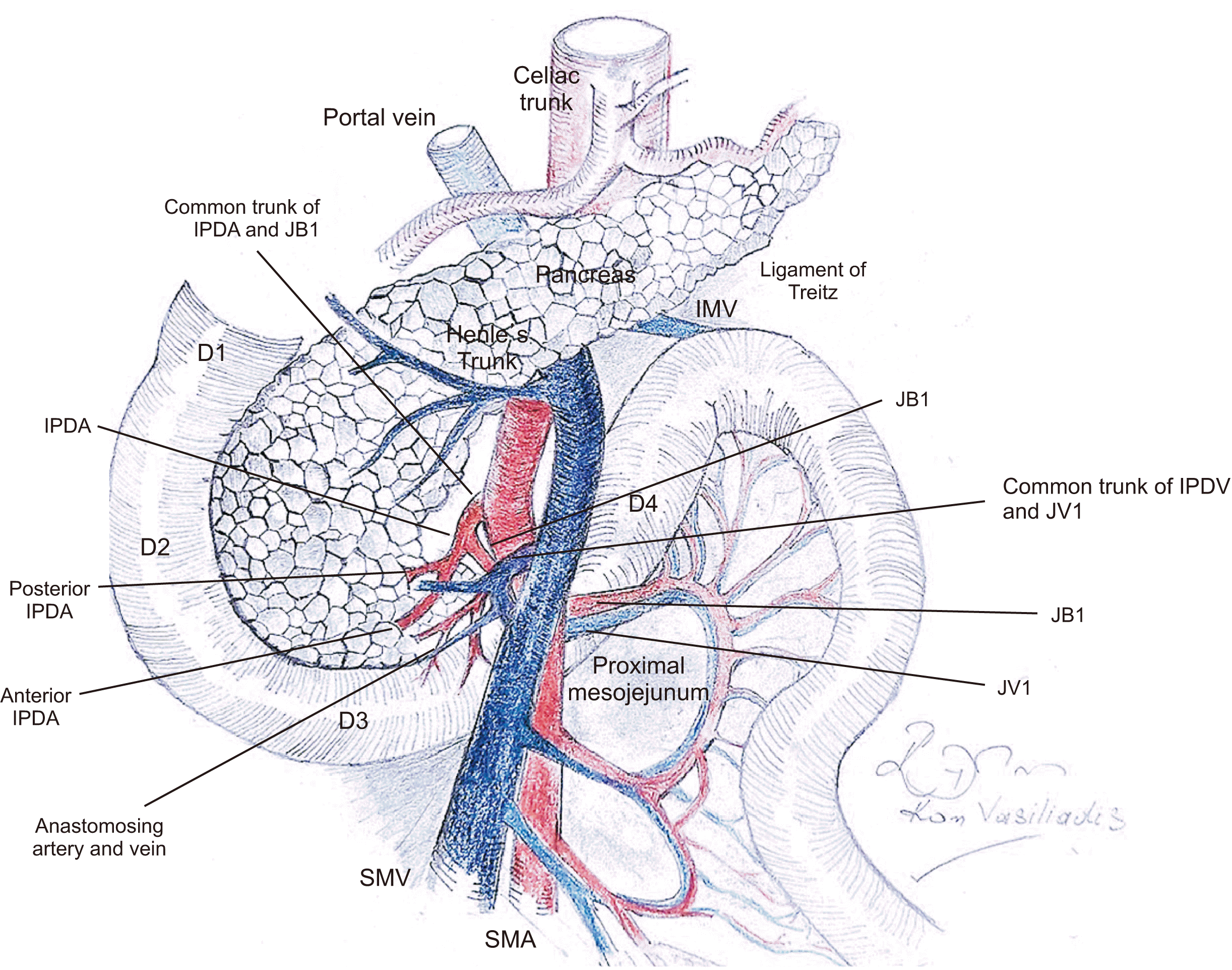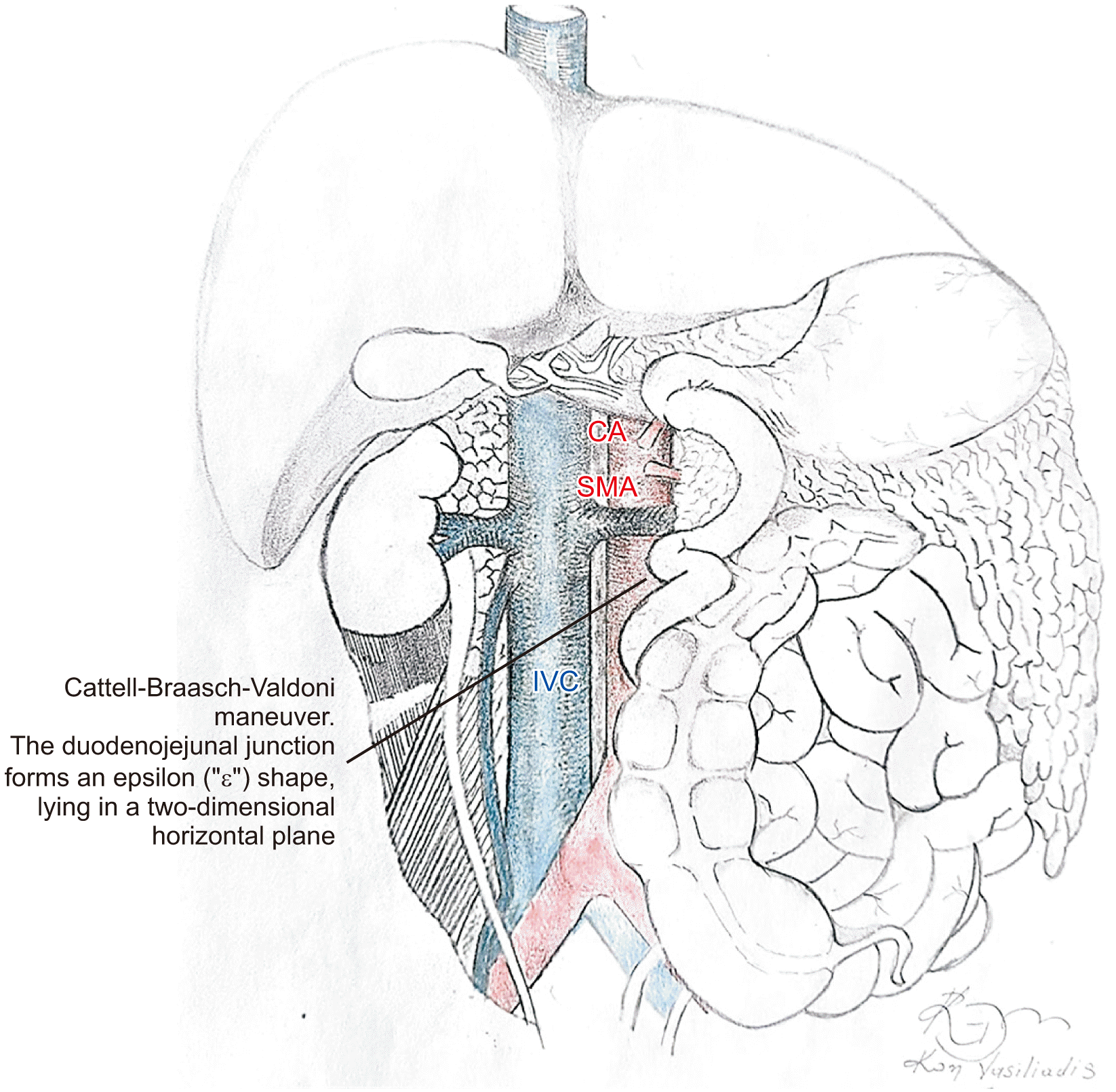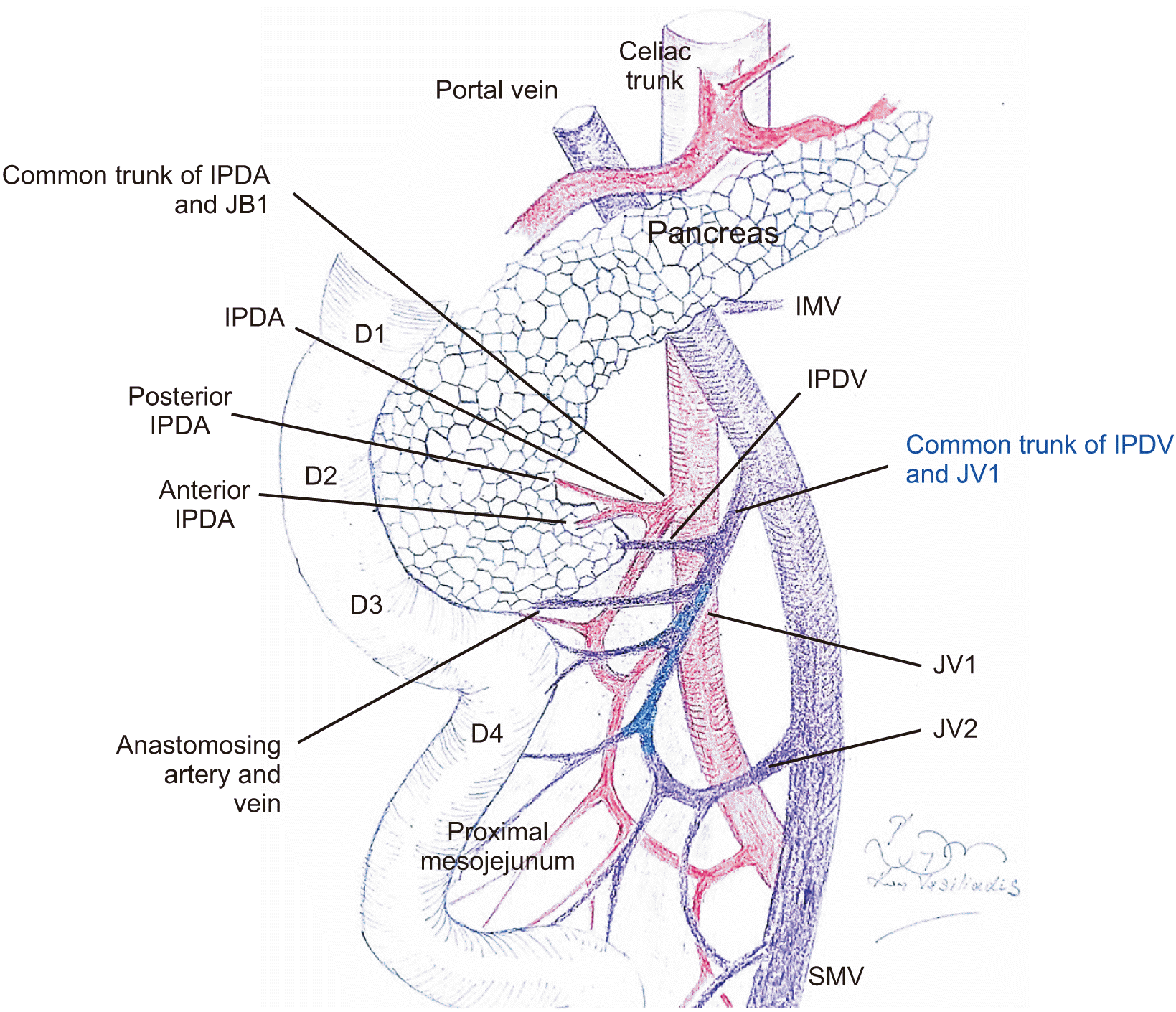1. Kimura W. 2000; Surgical anatomy of the pancreas for limited resection. J Hepatobiliary Pancreat Surg. 7:473–479. DOI:
10.1007/s005340070017. PMID:
11180873.

2. Gaedcke J, Gunawan B, Grade M, Szöke R, Liersch T, Becker H, et al. 2010; The mesopancreas is the primary site for R1 resection in pancreatic head cancer: relevance for clinical trials. Langenbecks Arch Surg. 395:451–458. DOI:
10.1007/s00423-009-0494-8. PMID:
19418067. PMCID:
PMC2848727.

3. Esposito I, Kleeff J, Bergmann F, Reiser C, Herpel E, Friess H, et al. 2008; Most pancreatic cancer resections are R1 resections. Ann Surg Oncol. 15:1651–1660. DOI:
10.1245/s10434-008-9839-8. PMID:
18351300.

4. Adham M, Singhirunnusorn J. 2012; Surgical technique and results of total mesopancreas excision (TMpE) in pancreatic tumors. Eur J Surg Oncol. 38:340–345. DOI:
10.1016/j.ejso.2011.12.015. PMID:
22264964.

5. Peparini N, Chirletti P. 2012; Clearance of the retropancreatic margin in pancreatic carcinomas: total mesopancreas excision or extended lymphadenectomy? Eur J Surg Oncol. 38:1146. author reply 1147. DOI:
10.1016/j.ejso.2012.07.004. PMID:
22819328.

6. Inoue Y, Saiura A, Yoshioka R, Ono Y, Takahashi M, Arita J, et al. 2015; Pancreatoduodenectomy with systematic mesopancreas dissection using a supracolic anterior artery-first approach. Ann Surg. 262:1092–1101. DOI:
10.1097/SLA.0000000000001065. PMID:
25587814.

7. Neoptolemos JP, Palmer DH, Ghaneh P, Psarelli EE, Valle JW, Halloran CM, et al. 2017; Comparison of adjuvant gemcitabine and capecitabine with gemcitabine monotherapy in patients with resected pancreatic cancer (ESPAC-4): a multicentre, open-label, randomised, phase 3 trial. Lancet. 389:1011–1024. DOI:
10.1016/S0140-6736(16)32409-6. PMID:
28129987.

8. Sharma D, Isaji S. 2016; Mesopancreas is a misnomer: time to correct the nomenclature. J Hepatobiliary Pancreat Sci. 23:745–749. DOI:
10.1002/jhbp.402. PMID:
27734589.

9. Peparini N. 2015; Mesopancreas: a boundless structure, namely the rationale for dissection of the paraaortic area in pancreaticoduodenectomy for pancreatic head carcinoma. World J Gastroenterol. 21:2865–2870. DOI:
10.3748/wjg.v21.i10.2865. PMID:
25780282. PMCID:
PMC4356904.

10. Hartwig W, Vollmer CM, Fingerhut A, Yeo CJ, Neoptolemos JP, Adham M, et al. International Study Group on Pancreatic Surgery. 2014; Extended pancreatectomy in pancreatic ductal adenocarcinoma: definition and consensus of the International Study Group for Pancreatic Surgery (ISGPS). Surgery. 156:1–14. DOI:
10.1016/j.surg.2014.02.009. PMID:
24856668.

11. Borghi F, Gattolin A, Garbossa D, Bogliatto F, Garavoglia M, Levi AC. 1998; Embryologic bases of extended radical resection in pancreatic cancer. Arch Surg. 133:297–301. DOI:
10.1001/archsurg.133.3.297. PMID:
9517744.

12. Hagai H. 2003; Configurational anatomy of the pancreas: its surgical relevance from ontogenetic and comparative-anatomical viewpoints. J Hepatobiliary Pancreat Surg. 10:48–56. DOI:
10.1007/s10534-002-0796-6. PMID:
12918457.

13. Isaji S, Murata Y, Kishiwada M. Neoptolemos J, Urrutia R, Abbruzzese J, Büchler M, editors. 2018. New Japanese classification of pancreatic cancer. Pancreatic cancer. Springer;New York: p. 1021–1037. DOI:
10.1007/978-1-4939-7193-0_84.

14. Schneider M, Strobel O, Hackert T, Büchler MW. 2019; Pancreatic resection for cancer-the Heidelberg technique. Langenbecks Arch Surg. 404:1017–1022. DOI:
10.1007/s00423-019-01839-1. PMID:
31728630.

15. Japan Pancreas Society. 2003. Classification of pancreatic carcinoma. 2nd English edition. Kanehara;Tokyo:
16. Peparini N. 2016; Para-aortic dissection in pancreaticoduodenectomy with mesopancreas excision for pancreatic head carcinoma: not only an N-staging matter. J Gastrointest Surg. 20:1080–1081. DOI:
10.1007/s11605-016-3131-1. PMID:
27000126.

17. Ohigashi H, Ishikawa O, Eguchi H, Yamada T, Sasaki Y, Noura S, et al. 2004; Early ligation of the inferior pancreaticoduodenal artery to reduce blood loss during pancreaticoduodenectomy. Hepatogastroenterology. 51:4–5. PMID:
15011818.
19. Hackert T, Werner J, Weitz J, Schmidt J, Büchler MW. 2010; Uncinate process first--a novel approach for pancreatic head resection. Langenbecks Arch Surg. 395:1161–1164. DOI:
10.1007/s00423-010-0663-9. PMID:
20582600.

20. Pessaux P, Varma D, Arnaud JP. 2006; Pancreaticoduodenectomy: superior mesenteric artery first approach. J Gastrointest Surg. 10:607–611. DOI:
10.1016/j.gassur.2005.05.001. PMID:
16627229.

21. Varty PP, Yamamoto H, Farges O, Belghiti J, Sauvanet A. 2005; Early retropancreatic dissection during pancreaticoduodenectomy. Am J Surg. 189:488–491. DOI:
10.1016/j.amjsurg.2005.01.007. PMID:
15820467.

22. Horiguchi A, Ishihara S, Ito M, Nagata H, Shimizu T, Furusawa K, et al. 2007; Pancreatoduodenectomy in which dissection of the efferent arteries of the head of the pancreas is performed first. J Hepatobiliary Pancreat Surg. 14:575–578. DOI:
10.1007/s00534-006-1198-x. PMID:
18040623.

23. Xu J, Tian X, Chen Y, Ma Y, Liu C, Tian L, et al. 2017; Total mesopancreas excision for the treatment of pancreatic head cancer. J Cancer. 8:3575–3584. DOI:
10.7150/jca.21341. PMID:
29151943. PMCID:
PMC5687173.

24. Cattell RB, Braasch JW. 1960; A technique for the exposure of the third and fourth portions of the duodenum. Surg Gynecol Obstet. 111:378–379. PMID:
13808480.
25. Sugiyama M, Suzuki Y, Nakazato T, Yokoyama M, Kogure M, Abe N, et al. 2016; Intestinal derotation procedure for facilitating pancreatoduodenectomy. Surgery. 159:1325–1332. DOI:
10.1016/j.surg.2015.11.014. PMID:
26767309.

26. Akita M, Yamasaki N, Miyake T, Mimura K, Maeda E, Nishimura T, et al. 2020; Cattell-Braasch maneuver facilitates the artery-first approach and complete excision of the mesopancreas for pancreatoduodenectomy. J Surg Oncol. 121:1126–1131. DOI:
10.1002/jso.25892. PMID:
32141084.

27. Papavasiliou P, Arrangoiz R, Zhu F, Chun YS, Edwards K, Hoffman JP. 2012; The anatomic course of the first jejunal branch of the superior mesenteric vein in relation to the superior mesenteric artery. Int J Surg Oncol. 2012:538769. DOI:
10.1155/2012/538769. PMID:
22489264. PMCID:
PMC3303700.

28. Ishikawa Y, Ban D, Matsumura S, Mitsunori Y, Ochiai T, Kudo A, et al. 2017; Surgical pitfalls of jejunal vein anatomy in pancreaticoduodenectomy. J Hepatobiliary Pancreat Sci. 24:394–400. DOI:
10.1002/jhbp.451. PMID:
28342263.

29. Sakaguchi T, Suzuki S, Morita Y, Oishi K, Suzuki A, Fukumoto K, et al. 2010; Analysis of anatomic variants of mesenteric veins by 3-dimensional portography using multidetector-row computed tomography. Am J Surg. 200:15–22. DOI:
10.1016/j.amjsurg.2009.05.017. PMID:
20074695.

30. Horiguchi A, Ishihara S, Ito M, Nagata H, Asano Y, Yamamoto T, et al. 2008; Multislice CT study of pancreatic head arterial dominance. J Hepatobiliary Pancreat Surg. 15:322–326. DOI:
10.1007/s00534-007-1261-2. PMID:
18535772.

31. Horiguchi A, Ishihara S, Ito M, Asano Y, Yamamoto T, Miyakawa S. 2010; Three-dimensional models of arteries constructed using multidetector-row CT images to perform pancreatoduodenectomy safely following dissection of the inferior pancreaticoduodenal artery. J Hepatobiliary Pancreat Sci. 17:523–526. DOI:
10.1007/s00534-009-0261-9. PMID:
20714842.

32. Negoi I, Beuran M, Hostiuc S, Negoi RI, Inoue Y. 2018; Surgical anatomy of the superior mesenteric vessels related to pancreaticoduodenectomy: a systematic review and meta-analysis. J Gastrointest Surg. 22:802–817. DOI:
10.1007/s11605-018-3669-1. PMID:
29363018.

33. Kobayashi Y, Sakamoto Y, Arita J, Akamatsu N, Kaneko J, Hasegawa K, et al. 2018; Vascular anatomy of the jejunal mesentery and complications associated with division of the first jejunal venous trunk during pancreaticoduodenectomy. J Surg Oncol. 117:1297–1304. DOI:
10.1002/jso.24948. PMID:
29205361.

34. Hongo N, Mori H, Matsumoto S, Okino Y, Ueda S, Shuto R. 2010; Anatomical variations of peripancreatic veins and their intrapancreatic tributaries: multidetector-row CT scanning. Abdom Imaging. 35:143–153. DOI:
10.1007/s00261-007-9195-3. PMID:
17594120.

35. Yamada Y, Mori H, Kiyosue H, Matsumoto S, Hori Y, Maeda T. 2000; CT assessment of the inferior peripancreatic veins: clinical significance. AJR Am J Roentgenol. 174:677–684. DOI:
10.2214/ajr.174.3.1740677. PMID:
10701608.
36. Kim HJ, Ko YT, Lim JW, Lee DH. 2007; Radiologic anatomy of the superior mesenteric vein and branching patterns of the first jejunal trunk: evaluation using multi-detector row CT venography. Surg Radiol Anat. 29:67–75. DOI:
10.1007/s00276-006-0153-5. PMID:
17033735.

37. Valdoni P. 1974. Chirurgia addominale: tecniche operatorie. Casa Editrice Francesco Vallardi;Milano:
38. Tocchi A, Mazzoni G, Puma F, Miccini M, Cassini D, Bettelli E, et al. 2003; Adenocarcinoma of the third and fourth portions of the duodenum: results of surgical treatment. Arch Surg. 138:80–85. DOI:
10.1001/archsurg.138.1.80. PMID:
12511157.
39. Bechi P, Maltinti G. 2014; A novel "salvage" indication to intestinal derotation procedure: reconstruction after duodenopancreatectomy. Am J Case Rep. 15:322–325. DOI:
10.12659/AJCR.889793. PMID:
25072806. PMCID:
PMC4116345.

40. Del Chiaro M, Segersvärd R, Rangelova E, Coppola A, Scandavini CM, Ansorge C, et al. 2015; Cattell-Braasch maneuver combined with artery-first approach for superior mesenteric-portal vein resection during pancreatectomy. J Gastrointest Surg. 19:2264–2268. DOI:
10.1007/s11605-015-2958-1. PMID:
26423804.

41. Virgilio E, Amodio PM, Scorsi A, Goglia A, Macarone Palmieri R. 2016; Advantages of the maneuver of intestinal derotation for pancreaticoduodenectomy. J Invest Surg. 29:359–365. DOI:
10.3109/08941939.2016.1160166. PMID:
27096254.

42. Nakamura M, Nakashima H, Tsutsumi K, Matsumoto H, Muta Y, Ueno D, et al. 2013; First jejunal vein oriented mesenteric excision for pancreatoduodenectomy. J Gastroenterol. 48:989–995. DOI:
10.1007/s00535-012-0697-6. PMID:
23076543.

43. Katz MH, Fleming JB, Pisters PW, Lee JE, Evans DB. 2008; Anatomy of the superior mesenteric vein with special reference to the surgical management of first-order branch involvement at pancreaticoduodenectomy. Ann Surg. 248:1098–1102. DOI:
10.1097/SLA.0b013e31818730f0. PMID:
19092356.

44. Sugiyama M, Suzuki Y, Nakazato T, Yokoyama M, Kogure M, Matsuki R, et al. 2020; Vascular anatomy of mesopancreas in pancreatoduodenectomy using an intestinal derotation procedure. World J Surg. 44:3441–3448. DOI:
10.1007/s00268-020-05605-z. PMID:
32474625.

45. Dandekar U, Dandekar K, Chavan S. 2015; Right hepatic artery: a cadaver investigation and its clinical significance. Anat Res Int. 2015:412595. DOI:
10.1155/2015/412595. PMID:
26788371. PMCID:
PMC4695647.

46. Jah A, Jamieson N, Huguet E, Praseedom R. 2009; The implications of the presence of an aberrant right hepatic artery in patients undergoing a pancreaticoduodenectomy. Surg Today. 39:669–674. DOI:
10.1007/s00595-009-3947-3. PMID:
19639433.

47. Takasaki K, Yamamoto M, Tsugita M, Ootsubo T, Imaizumi T, Yoshikawa T. 1997; N Nine-year patency of a vascular prosthesis used for portal vein reconstruction during pancreatoduodenectomy. J Hepatobiliary Pancreat Surg. 4:127–130. DOI:
10.1007/BF01211354.
48. Herscu G, Wilson SE. 2009; Prosthetic infection: lessons from treatment of the infected vascular graft. Surg Clin North Am. 89:391–401. viiiDOI:
10.1016/j.suc.2008.09.007. PMID:
19281890.

49. Fujisaki S, Tomita R, Fukuzawa M. 2001; Utility of mobilization of the right colon and the root of the mesentery for avoiding vein grafting during reconstruction of the portal vein. J Am Coll Surg. 193:576–578. DOI:
10.1016/S1072-7515(01)01039-0. PMID:
11708518.
50. Muttillo EM, Felli E, Pessaux P. 2020; Cattell-Braasch maneuver in pancreatic surgery. No need of venous graft for vascular resection. J Surg Oncol. 122:1612–1615. DOI:
10.1002/jso.26180. PMID:
32820545.







 PDF
PDF Citation
Citation Print
Print



 XML Download
XML Download